
views
Using Home Remedies to Relieve a Sore Throat
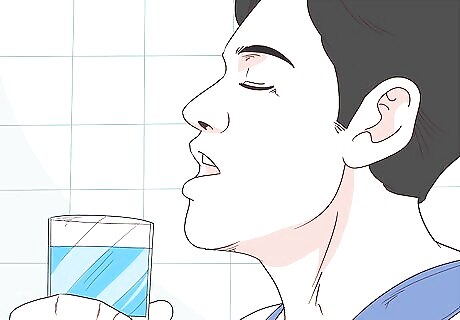
Gargle to help reduce swelling and relieve discomfort. Mix 1 teaspoon of salt into 8 ounces of warm water. Take the liquid into the back of your throat, gargle with your head turned slightly up, and spit the water out. Gargle once every hour or so. You should wash your mouth out after so your mouth doesn't taste too bad. Optional: Put one teaspoon of lemon juice or vinegar in the water and gargle as usual. Do not swallow!
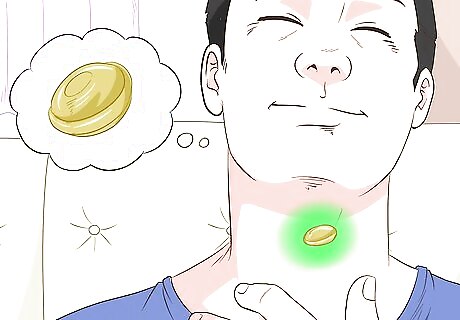
Use nonprescription throat lozenges for relief. Many herbal lozenges that you can buy over the counter contain analgesics like lemon or honey. Some throat lozenges, like Sucrets Maximum Strength or Spec-T, are safe and effective and contain medicine (local anesthetic) that numbs the throat to soothe pain. Try not to consume analgesic lozenges for more than three days, as the anesthetics could mask a serious bacterial infection such as Streptococcus (strep throat) that needs medical intervention.
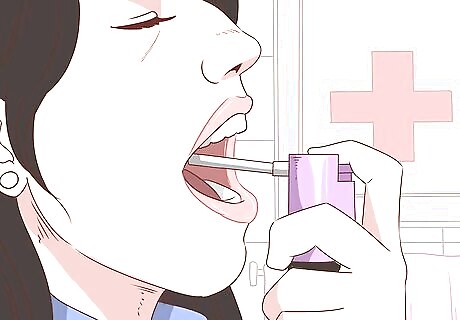
Use throat sprays for relief. Like lozenges, throat sprays such as Cepacol, help relieve pain by numbing the lining of the throat. Follow instructions on labeling for proper dosage, and consult a doctor or pharmacist for information regarding use with other medications and/or remedies.

Soothe your throat pain with a warm compress. You can soothe pain on the inside of your throat with warm tea, lozenges, and throat sprays, but how about attacking the pain from the outside? Wrap a warm compress around the outside of your throat. This could be a warm heating pad, a hot water bottle, or a warm, damp cloth.
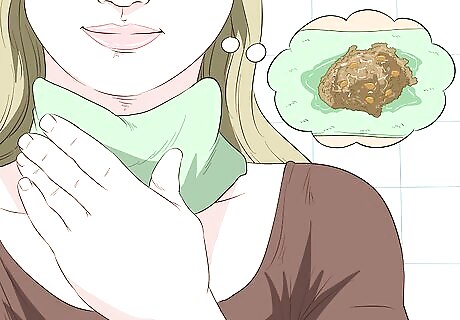
Make a compress out of chamomile. Make a batch of chamomile tea (or soak 1 tablespoon dried chamomile flowers in one to two cups boiling water and let steep). Once the tea is warm enough to touch, soak a clean towel in the tea, wring it out, and apply to neck area. Leave it there for 30-45 minutes and repeat several times a day, if you need to. Alternatively, you can buy chamomile flowers and put it in a teapot and let it sit for five minutes in hot water.
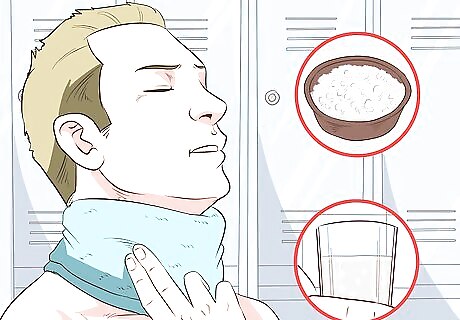
Make a plaster with sea salt and water. Mix 2 cups sea salt with 5 to 6 tablespoons (73.9 to 88.7 ml) lukewarm water to create a damp, but not wet, mixture. Put the salt in the center of a clean dishtowel. Roll the towel along its longer side and wrap the towel around your neck. Cover the plaster with another dry towel. Leave on for as long as you wish.
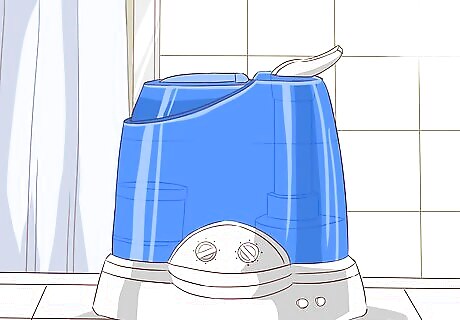
Use humidifiers or steam treatments for relief. Warm or cool mist moving through a humidifier can help soothe your throat, although take care not to make your room uncomfortably cold or damp. Use a steam treatment with warm water and a dishtowel. Bring 2-3 cups of water to a soft boil and remove from heat. (Optional: steep chamomile, ginger, or lemon tea in the water.) Lest rest for about 5 minutes. Put your hand over the steam coming off the water to test if it is too hot. Pour the water into a large bowl, drape a clean dishtowel over your head, and bring your covered head over the steam issuing from the bowl. Breathe deeply through your mouth and nose for 5-10 minutes. Repeat as necessary.
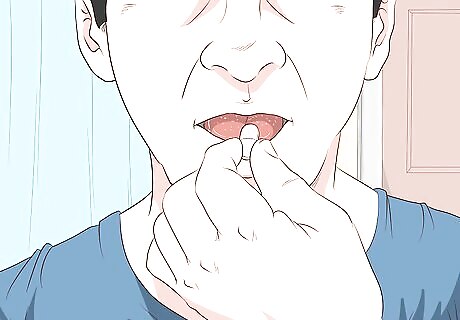
Take acetaminophen or ibuprofen. For pain relief, it's okay to take acetaminophen and ibuprofen. Avoid giving children under the age of 20 any aspirin. The combination has been linked to a serious condition called Reye syndrome. Follow dosage instruction on the label exactly.
Relieving Your Sore Throat with General Health Practices

Get plenty of rest. Try to sleep during the day, if possible and maintain your regular sleeping schedule for the night. Shoot to sleep more than your usual daily allotment, about 11-13 hours while symptoms last.
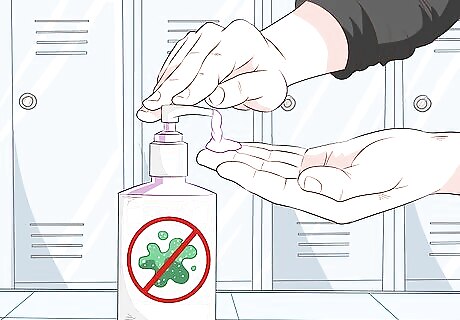
Wash or sanitize your hands frequently. It's no secret that our hands are vectors for bacteria: We touch our face and other objects, increasing the likelihood of spreading bacteria. Wash your hands frequently if you have a sore throat or cold in order to prevent as much bacterial transmission.

Drink plenty of fluids, especially water. Water may help thin secretions in the throat, and warmer fluids help soothe irritation in the throat. Hydrating your body will help it fight off infections and clear the sore throat quickly. Tip: Shoot for three liters (13 cups) of water a day for men, and 2.2 liters (9 cups) of water a day for women. Drink a warm chamomile or ginger tea to soothe your throat. Mix a hot drink of Manuka honey, lemon, and warm water. If you can’t find Manuka honey, go with regular. Drinking electrolyte-rich sports drinks, such as Gatorade, will help your body replenish the salts, sugars, and other necessary minerals it needs to fight the sore throat.
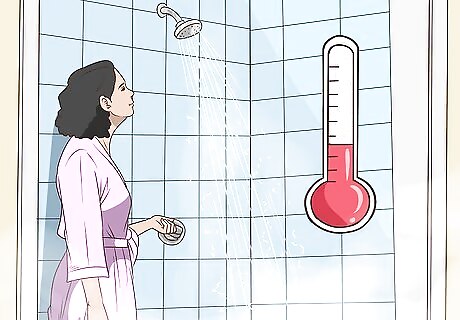
Take showers every morning and every night. Take frequent, steamy showers. Showering will help clean your body, offer a refreshing diversion, and allow the steam a chance to soothe your throat.

Take vitamin C. Vitamin C acts as an antioxidant, protecting cells from the damage caused by free radicals. Free radicals are compounds formed when our bodies convert the food we eat into energy. The scientific evidence about whether vitamin C specifically helps sore throats is controversial, but it certainly won't hurt your sore throat. You might as well take it. Other antioxidant-rich foods include: green tea, blueberries and cranberries, beans (pinto beans, kidney beans, and black beans), artichokes, prunes, apples, and pecans, among others.

Make garlic tea. This can work well, as garlic is a natural antibiotic. Cut some fresh garlic into small pieces (medium slices). Put the garlic pieces into a mug/teacup. Fill with water. Put the cup inside of the microwave. Boil for two minutes. Remove the cup. While still hot, take out the pieces of garlic. Add your favorite tea bag (preferably a flavored one to kill the smell of garlic), such as vanilla flavor. Add some honey or other sweetener (enough to make drinking tasty). Drink (it will taste really good thanks to the tea bag and sweetener). You can have as many cups as you like.
Avoiding Certain Foods While Symptoms Persist
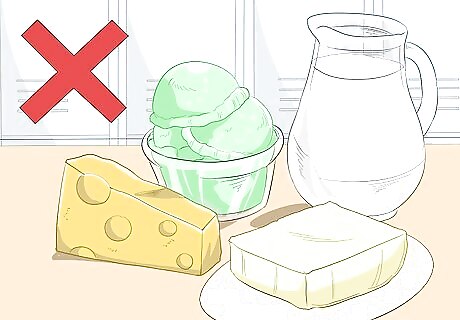
Avoid dairy foods, if they make you feel worse. Studies have proven that there’s no real connection between how much dairy you consume and the amount of mucus you have. However, some people feel more stuffy after eating dairy when they have a sore throat or cold. Try a dairy product, such as a cup of yogurt, some cheese, or a glass of milk. If you feel fine afterwards, you can continue eating dairy. If your throat hurts more or you feel more stuffy, consider eating less of it while you’re still sick..
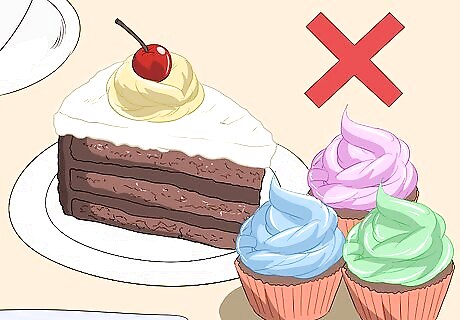
Avoid overly sugary foods, such as cupcakes or cake. Eating sugary, processed food with low nutritional value won’t give you the vitamins and minerals you need to feel better. Sugary foods that are dry, like cake and cupcakes, are even worse, as they’ll be scratchy on your throat and hard to swallow. Tip: If you’re craving something sweet, opt for fruit or vegetable smoothies. For breakfast, try warm oatmeal. A cream-based soup or warm broth will also help you feel better.
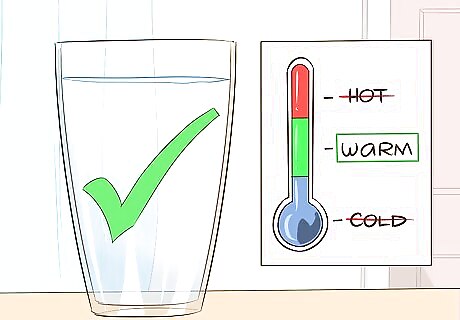
Avoid cold foods and drinks. Don't let the cooling sensation of drinks and ice cream fool you: You want to keep your body's core temperature up. Warm drinks, like tea, are the best to drink. If you just want water, try to drink it hot or at least lukewarm.
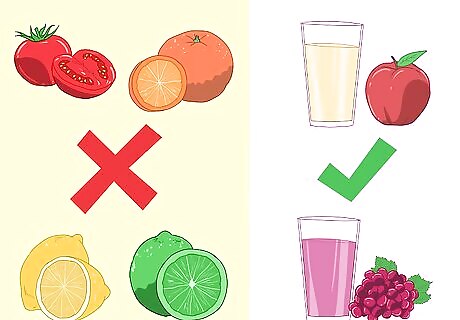
Try not to eat citrus fruits. Fruits like oranges, lemons, limes, and tomatoes can hurt your throat even more. Instead, opt for grape or apple juice, which are fruity and refreshing but not acidic. Did you know? There is an urban legend that orange juice is good for a sore throat as it is full of vitamin C but the acidity will just cause more irritation and pain to the throat.
Seeking Medical Attention

See a doctor if your sore throat lasts for more than three days. It's better to be safe than sorry. Your doctor can look at your throat, discuss your symptoms, and perform tests that hopefully will put you back on the path to a quick recovery.

Check for signs of strep throat. Your sore throat is probably just that — sore. But there's a chance what you thought was sore throat is, in fact, strep throat or another potentially hazardous infection. Be on the lookout for these signs that you have strep throat: Severe and sudden sore throat without the usual signs of common cold (coughing, sneezing, runny nose, etc.). Fever over 101° F (38.3° C). Lower fevers suggest increased likelihood of viral infection, not strep. Swollen lymph nodes in the neck. White or yellow spots or coating on the throat and tonsils. Bright red throat or dark red spots on the roof of the mouth at the back near the throat. Scarlet blotches in the neck area or other parts of the body.
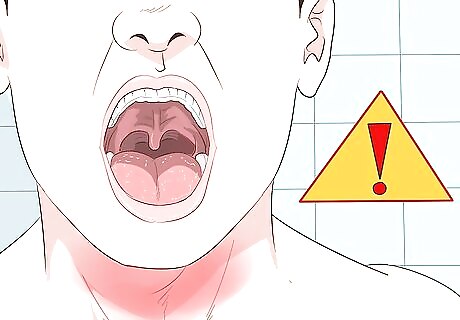
Check for signs of mononucleosis, or mono. Mono is caused by the Epstein-Barr virus and is usually associated with teens and young adults, as most adults have immunity to the virus. Symptoms of mono include: High fever, anywhere from 101° - 104° F (38.3° - 40° C), with attendant chills. Sore throat, with white patches on the tonsils. Swollen tonsils and swollen lymph nodes all over the body. Headache, fatigue, and a lack of energy. Pain in the upper left side of the abdomen, near your spleen. If your spleen hurts, seek medical attention immediately, as it could mean that your spleen has burst.



















Comments
0 comment